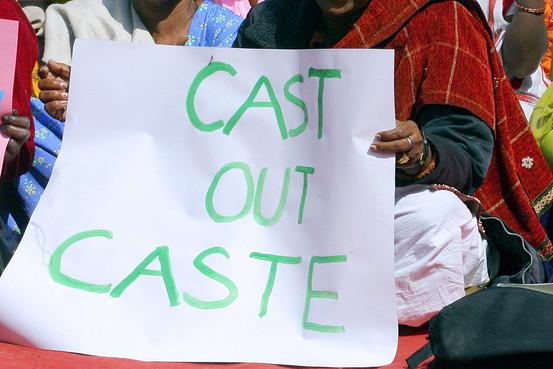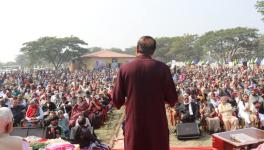What Yogendra Yadav, Pratap Bhanu Mehta Don’t Get About Secularism

Representational image. | Image Courtesy: Wall Street Journal
The bhoomipujan for the Ram temple in Ayodhya, on 5 August, has spawned a rich vein of analyses on the decline or demise of secularism. Yet, quite surprisingly, the word caste has been missing from these accounts. Although elite liberal nationalists of a certain generation often clubbed together the “evils of caste and communalism”, these two Cs have to be linked to better comprehend the world around us.
We have to understand that to expect a harmonious relationship between Hindus and Muslims is just not possible in a socio-political environment structured by gross inequalities, which are justified as constituting a “natural order” sanctioned by tradition. This natural order is sought to be upheld through the instrument of violence—or through the threat of its use.
Untouchability may have been abolished, the principle of equality may have been enshrined in the Constitution, but India’s notorious caste system still reigns supreme. It is our fantasy to presume that equality can govern the Hindu-Muslim relationship when the largest segment of the society accepts, even celebrates, the ordering of social groups in a hierarchy. The lower a group is placed on the Hindu social ladder, the less rights its members possess. It is therefore impossible to conceive equality in one segment of a social system that pervades with inequality, normalised and even idealised.
Yet the lower castes have struggled to change the unequal social structure for well over a century. Matching their efforts is also the century-old project of the Hindu Right, comprising, in the main, the Hindu Mahasabha and the Rashtriya Swayamsevak Sangh, to unite the Hindus under the stewardship of the upper castes. The primary purpose of this project has been to thwart the subaltern challenge to change the socio-cultural status quo, a challenge which has intensified with the rise and deepening of democratic politics, most spectacularly over the last four decades.
Ratcheting up the demonisation of Muslims has always been the go-to strategy of the Hindu Right when faced with subaltern challenges. This has enabled Hindutva to either ignore, subvert, or attempt to co-opt lower caste movements seeking social justice. Hindutva has acquired new successes in this regard because of Prime Minister Narendra Modi, who harps on his OBC (Other Backward Classes) identity and portrays himself as a chaiwalla.
From this perspective, the rising conflict between India’s two religious communities is not evidence of the failing of an abstract secularism, or its lack of resonance among Indians, as some political pundits have opined. This conflict is a product of politics that seeks to maintain and reinforce the status quo by displacing subaltern anger on to a more easily targeted religious minority.
Yet these aspects of our democratic politics is ignored by political scientist Yogendra Yadav, who, in a recent essay, says secularism was “defeated because it failed to connect with the language of traditions, because it refused to learn or speak the language of our religions.” Yet it is the same language of traditions and religions that have sanctified social inequality.
Yadav also says that “secularism was defeated because it chose to mock Hinduism instead of developing a new interpretation of Hinduism suitable for our times.” Would a new interpretation of Hinduism simultaneously foster equal respect for all religions as also for all castes, even the most lowly? Can we really think of religion and secularism without referencing caste?
In a counter to Yadav, columnist and academician Pratap Bhanu Mehta argues that “taking religion seriously as a political matter will solve the communal problem is a historically dubious proposition.” Mehta cites examples to bolster his proposition. He goes on to say, with candour, “Let us name the beast for what it is and not hide behind the pieties of secularism or religion.” And that beast, according to Mehta, is the “growing tolerance for prejudice” that is “largely about marginalising Muslims from the Indian narrative.”
Yet Mehta does not explain why the beast has begun to behave in utter disregard for humanity. In fact, what is germane to any discussion on the decline of secularism is to identify the precise historical juncture at which Mehta’s beast emerged—and why its behaviour has increasingly turned unruly and scary.
A range of writers has traced the beast’s emergence to the successive rules of Indira Gandhi and Rajiv Gandhi. They have pointed out, rightly so, that Hindutva acquired credence because Mrs. Gandhi brazenly played the Hindu card after returning to power, following the collapse of the Janata Party experiment, in 1980.
She turned the Punjab problem into a Hindu-Sikh issue, openly courted Hindus during the elections in Jammu and Kashmir in 1983, and fanned the majority community’s anxieties. These anxieties were heightened further by the storming of the Golden Temple in 1984 and the pogrom against the Sikhs following her own assassination later that year.
On succeeding his mother, Rajiv Gandhi overturned the Supreme Court judgement in the Shah Bano case, banned Salman Rushdie’s The Satanic Verses, and then, to balance the mollycoddling of the conservative Muslim leadership, it is claimed that he had the locks on the gates of the Babri masjid opened.
This narrative does not explain the transformation of the Gandhis and the Congress from 1980. Their change was not inexplicable as it seems.
For Mrs. Gandhi, the substitution of the secular card for the Hindu one was a strategy to check the mass base of the Congress from shrinking, a consequence of the desertion and assertion of lower castes, particularly the OBCs. From being vertically integrated or accommodated by the upper caste leadership of the Congress, these groups wished to exercise power on their own.
The signs of this incipient caste struggle became visible in the 1967 elections: Congress was voted out of power in several states in North India. In his paper, The Rise of the Other Backward Classes in the Hindi Belt, Christophe Jaffrelot shows that 1967 saw the election of a number of lower-caste MLAs, particularly Yadavs, “whose number had increased so much as to be just behind the Rajputs (14.8 per cent as against 24.1 per cent.).” In February 1968, BP Mandal became the first OBC chief minister of Bihar; out of the nine chief ministers who governed the state from March 1967 to December 1971, only two belonged to the higher castes.
But the assertion of the lower castes at the national level was checked because of Mrs. Gandhi scripting India’s victory over Pakistan in the 1971 war. She loomed over Indian polity, her stature rising further because of measures such as the abolition of the Privy Purse and the nationalisation of banks and mines, all these stitched together seamlessly for the “garibi hatao” campaign. These policies did stem the Congress rot.
The 1977 elections, however, provided incontrovertible evidence that the shrinking base of her party was not temporary, as Muslims and Dalits, in reaction to the Emergency excesses committed against them, began to show signs of shifting away from the Congress and Gandhi. Once again, post-Emergency, lower caste leaders such as Karpoori Thakur in Bihar and Ram Naresh Yadav in Uttar Pradesh were back as chief ministers. They took to implementing the quota system for the OBCs in government jobs.
The upper caste hegemony stood challenged, a fact Mrs. Gandhi recognised. She chose to play the Hindu card for subsuming the caste identity of subaltern groups into the larger Hindu identity—and thwarting their assertion. Nationalism was put on a diet of steroids to counter Sikh militancy. Her politics constituted the backdrop for the 1980s turning into a decade of riots—apart from the pogrom against Sikhs, there were bloodbaths in Meerut, Moradabad, Bhagalpur, Nellie, etc.
The Muslim or M-factor for rallying the Hindus, that original project of the RSS, now acquired legitimacy. It is not a coincidence that the eighties were also when the RSS and its political affiliate—the Bharatiya Janata Party—decided to usher in the Ramjanmabhoomi movement.
So, when the VP Singh government decided to implement 27% reservation for OBCs, the upper castes expected a more forthright opposition from the Congress at the attempts to break their monopoly over government jobs—and the country’s power structure. The Congress could not because its legacy of being a catch-all party, of being something to everyone, would have alienated its supporters among subaltern groups, particularly the Dalits.
The upper castes turned to the RSS-BJP in the Hindi heartland, where the earlier failed project of uniting Hindus was revived—through the shilanyas programme in 1989, LK Advani’s yatra in 1990, then several kar sevas organised at Ayodhya over the next two years, ultimately culminating in the demolition of the Babri masjid on 6 December 1992. This was Hindutva’s invitation to Hindus of all castes to unite against the Muslims, who became collateral damage in the battle for supremacy between the upper castes and the lower castes.
This also marked the letting loose of the beast of prejudice, to prowl and howl, because that was the surest way to pushback subaltern assertions and let caste inequalities persist. The beast was uncaged and unchained not because of the failing of secularism, but because we subscribe to the inherent illiberalism of the caste system.
Having tasted blood, the beast will neither be easily caged nor chained for three reasons. One, the OBC leaders of the Hindi heartland did not try to craft caste politics into a broader movement for social justice, as for instance the Dravida Munnetra Kazhagam has done in Tamil Nadu over decades. They have also not tried to bridge, for instance, the chasm between the Dalits and the OBCs, who too deploy violence to silence the former.
Worse, OBC leaders have chased away from their outfits those leaders who could be a challenge to them. This has turned OBC parties into family-led outfits, relying, in the main, on one OBC caste, each competing for the support of Muslims. This has dissipated their energies.
At the same time, the upper caste leadership of the Congress still believes their caste brethren will tire of the BJP and return to them. This is why Congress leaders are so reluctant to speak out against the beast of prejudice. So also the OBC leaders, who feel Muslims cannot go to the BJP and, therefore, it is in their electoral interest to not alienate those besotted by the beast.
Two, there is the factor of Narendra Modi, whose own lower OBC persona, which he never fails to display in the Hindi heartland, will be a magnet to pull into the Hindutva fold those who traditionally constitute the social justice forces. His portrayal of himself as a chaiwalla only enhances his power to attract lower OBCs.
Three, as the Indian economy sputters and backfires, as woes of Indians multiply, the beast of prejudice and hatred will be whipped to roar continuously, against Muslims no doubt, but also against those who subscribe to the Liberal-Left ideologies. This was and will remain an essential element of what economist Jean Drèze has called “the revolt of the upper castes.” Unless this is recognised and opposed, and the quest for caste equality placed centre-stage, secularism will remain a failed ideology—and Muslims will bear the cross of prejudice.
The author is an independent journalist. The views are personal.
Get the latest reports & analysis with people's perspective on Protests, movements & deep analytical videos, discussions of the current affairs in your Telegram app. Subscribe to NewsClick's Telegram channel & get Real-Time updates on stories, as they get published on our website.
























